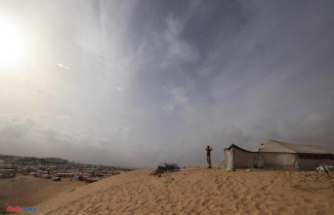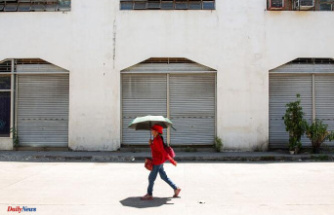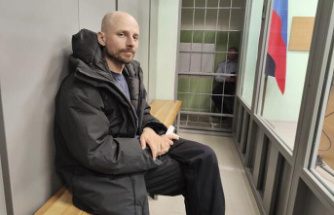Attention, state of emergency! Almost 360 days a year life ripples along in Villena. Not too many visitors get lost in the town in the hinterland of the Costa Blanca. But at the beginning of September, after the Corona break, emotions and decibels will explode again and attract legions of onlookers.
Then it's time for the six-day folk festival "Moros y Cristianos", which means "Moors and Christians". 15,000 participants are expected from September 4th to 9th.
After a two-year Corona break, one of the most popular fiestas in Spain, that of the Moros y Cristianos, is back. Far from historical logic, they give space to really let it rip. According to the festival association, there are around 400 of them in the Valencia region and throughout Spain.
Actually, these fiestas are reminiscent of triumphs from the Middle Ages, after the Christian Spaniards, who often acted anything but Christian, defeated the Muslim enemies of the faith. The foreigners, coming from North Africa, had established themselves on the Iberian Peninsula from 711 AD and held the reins in their hands for centuries.
However, festivals like in Villena are not about winners and losers. The audience is the winner. Provided you get involved in a multi-day spectacle that finds its climax in the parades. Up to 15,000 participants are then on their feet, which corresponds to about half of Villena's population.
This also means a record number of participants at all "Moorish and Christian" festivals in Spain. Raising the bar of what is commonly called normality is misplaced. Here there is a state of emergency, party frenzy, celebration excess.
María José Domene is in her exotic Moorish costume, to which the goggles from the hardware store, which she is now taking off, fit like a glove. She has just fired a volley of joy from her rifle in Villena's town hall square in honor of the patron saint of the festival, the "Virgin of Virtues", a sculpture of Mary that has a place of honor in the Church of St. James.
Question to María José: What is the biggest mistake that a non-local can make here? She thinks for a moment and clarifies: “Ask us if we dress up. No, we don't dress up, we dress up.” She herself belongs to the “Moros Nuevos” festival association, the “New Moors”.
The 14 festival associations, each consisting of seven "Moors" and seven "Christians", form the framework of the festival. Even outside of the great days, they are the social glue that holds the town together. María José emphasizes that there is no “competition between clubs” – but that is far from the truth. Because during the parades, everyone tries to put themselves in the foreground, to outdo the others.
The first highlight marks the "Gran Entrada", the "Great Entry" on September 5th. Grandstands and thousands of chairs for onlookers are lined up along the almost two-kilometer route. The spectacle lasts eight hours, a heightened carnival, a continuous performance, a street show with choreographies and spontaneous interludes.
The intoxication of the costumes and colors is accompanied by dozens of bands with their worlds of sound, a seemingly endless tremor. For timpani you need your own hand pull wagon, the melodies vibrate straight into your gut. Oriental foot soldiers are out and about in harem pants and pointy shoes, with scimitars and turbans. Riders put their horses on their hind legs and perform dressage exercises. It's raining streamers, confetti, applause.
The favorites of the masses are the "Moors", although there is none in person. Some are armed with shields and have bushy beards stuck on. Songs ring out from the fullest of throats, wild battle cries, also from women. And men don't shy away from wrong worlds: with eyeshadow and fishnet stockings. Stilt walkers also garner applause, as do young freestyle entertainers doing somersaults, standard bearers and flag bearers.
Some carry the flag in front and pour hip flasks during the parade, but no one visibly goes overboard. Groups in futuristic masquerades give the impression that delegations of spaceships are about to leave.
Historical credibility plays no role in this festival, which has been documented since the end of the Middle Ages. Just looking at piercings and tattoos is enough. Absolutely authentic, on the other hand, is the Spanish love of noise and joie de vivre, before which everything pales.
"Moros y Cristianos" is the best excuse to celebrate, to let it rip once a year - free of depth. No one is interested in the fact that historically the conflict between "Moors and Christians" was caused by wars and tragedies. For Andrés Luis Sánchez, who is in action with the "New Moors", the festival is "like Christmas, because then everyone comes together, family, friends."
Beware of shots! At festivals in Spain's Mediterranean region, people like it when there's a bang. Foreigners who love to preserve their eardrums should refrain from some program items in Villena. In scenic depictions of the conquest of the castle, which were only added in the 19th century, riflemen and women like María José Domene with hearing protection go into action. Then powder smoke settles over alleys and houses.
Things are quieter in the Jakobuskirche during the theatrical “Conversion of the Moorish leader to Christianity”. It never took place like this. And no one wonders what Amazons with bows and arrows and hollowed-out bird skulls are doing in the "Great Procession", the "Gran Cabalgata".
Or men with plastic axes made in China. A fiesta like this, which follows its own laws, its own dynamics, cannot be dealt with by logic. The motto is: The main thing is having a lot of fun.
Until the early hours of the morning, the festive tapeworm rolls through the flag-bedecked, illuminated streets. Each individual gets the maximum out of themselves. And quite literally, which is why many drummers plaster their fingertips in advance.
Eye-catchers are "monks" with a team of oxen. Ballet groups whirling their hearts out in feather headdresses. Lion-like masks, long fur trains, tons of makeup. Chivalrous outfits in which hairdresser Francisco Úbeda and driving instructor Jerónimo Hernández sweat side by side.
Miguel Vitoriano Navarro also enjoys bathing in the crowd, feeling carried away by the cheers, the shouts of Olé, the applause. Everything that he does not experience in his professional life as a wine merchant. "I'm like an actor who is putting on a play," enthuses Miguel, the self-promoter, the mood cannon, the cheerleader. He has known long enough that at the end of the festivities he is filled with melancholy: now he has to wait almost 360 days for the next fiesta to begin.
Arrival: For example with Eurowings from Düsseldorf to Alicante; with Ryanair from Berlin. Continue by rental car 55 kilometers northwest on the motorway to Villena.
Parades: The Tourist Office of Villena provides information about seat reservations for the parades. However, it is not absolutely necessary for spectators to reserve seats. You can also stand behind the rows along the track. The highlights are the parades "Gran Entrada" (September 5, from 4 p.m.) and "Gran Cabalgata" (September 6, from 9 p.m.).
Accommodation: There is little accommodation in Villena, private accommodation can be found on booking.com. Neighboring Biar offers alternatives, where things are quieter at night. There you will find the friendly furnished "Hotel Villa de Biar" (from 57 euros/double room, hotelvilladebiar.com; with pool) and the rural hotel "La Façana" (from 82 euros/double room, lafasana.com).
More information: Turismo Villena: turismovillena.com; Costa Blanca Tourist Region: www.costablanca.org; Spanish Tourist Office: spain.info
Participation in the trip was supported by the Spanish Tourist Office, the Costa Blanca Tourism Organization and the City of Villena. You can find our standards of transparency and journalistic independence at axelspringer.com/de/Werte/downloads.












